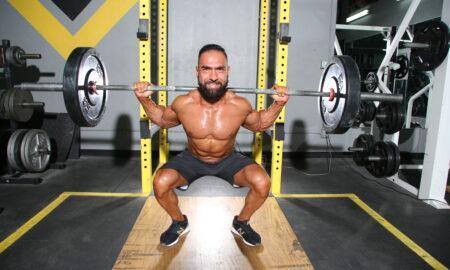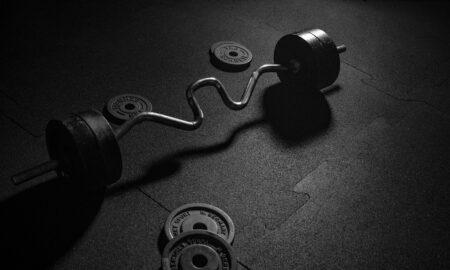“I don’t have time.”
“It’s bodybuilding I’m into.”
“Cardio’s for old guys. I’m only in my 40s.”
Cardio is the heart of over-40 bodybuilding. By strengthening your heart, cardio will help you to stay young for your years, which can only help your bodybuilding. While cardio is good for everyone, it should be considered essential for everyone over 40.
I used to find cardio boring, and I had trouble keeping it in my routine. Now, though, I look forward to doing it. Here’s the approach I follow. Try it yourself.
It’s a myth that you have to do lots of cardio. Actually, you can’t do lots of cardio because proper cardio is hard, and you can’t do a lot of hard work. What many people call “cardio” is gentle aerobic work. While that’s good for burning calories, it won’t do much for your heart.
Just two very brief cardio sessions each week will strengthen your heart and improve your fitness. The cardio I’m recommending is called the graded-exercise protocol, or GXP. It was developed by Dr. Robert Otto and then adapted and studied by Ralph N. Carpinelli, Lesley D. Fox, Richard A. Winett and Janet R. Wojcik.
Short-but-hard aerobic work results in increased aerobic capacity, or VO2 max, which appears to be the key to substantial cardiovascular health benefits. It depends more on intensity of exercise than duration.
The GXP is ideal for bodybuilders who find lower-intensity, longer-duration aerobic work boring and who want to invest minimum time in cardio work without compromising on benefits.
The protocol requires you to exercise at 85 percent of your maximum level for a mere five minutes. If you’ve exercised for many years, relying on 85 percent of the common estimation of maximum heart rate—220 minus your age—may not give you sufficient intensity to do the job. Here are two methods for getting a close approximation of 85 percent of your actual maximum heart rate:
Perceived exertion. An 85 percent of maximum heart rate is supposed to translate to 8.5 on a perceived-exertion scale of one to 10, with 10 your absolute limit—where exhaustion would occur in under one minute. If you find that 85 percent of your estimated maximum heart rate doesn’t equate to 8.5 on the perceived exertion scale, adjust it to be based on your perceived actual limit.
Talk test. The 85 percent of actual maximum heart rate is roughly the anaerobic threshold—the point at which your body can’t produce energy aerobically but shifts into anaerobic mode for a brief period before fatigue and discomfort force you to terminate the exercise. It’s roughly the point at which you can no longer converse but can only spit out words as you struggle to breathe. To use the graded-exercise protocol, you need to stay slightly below the anaerobic threshold.
Your perceived exertion of 8.5 should coincide with the aforementioned, give or take a few heartbeats. Take the midpoint of the two, and use that as your 85 percent of actual maximum heart rate.
An illustration. I’m 51 years old. My estimated maximum heart rate is 169—220 minus 51. And 85 percent of 169 is 144. But exercising at 144 beats per minute is comfortable for me, a perception of no more than 70 percent of my maximum. If I increase the work level to the point at which I can’t speak more than four or five words without gasping, my heart rate is around 165. My perception of exertion at 165 is about 85 percent—8.5 on a scale of one to 10. The 165 beats per minute is my 85 percent of actual maximum heart rate and a tad below my anaerobic threshold. That’s what I use, give or take a few heartbeats, during my GXP work. (A cardiologist gave me a thorough checkup, and I received his consent before performing hard cardio work.)
Do the same calculations for yourself to find your cardio-training level.
I run on a treadmill with a yielding belt and walk fast on a treadmill set at a slight incline. You could use a stepper, cross trainer, rower, ski machine or climber. Choose one that you enjoy, or rotate two or more that you like. You must enjoy what you’re doing if you’re to stick with it.
Make each cardio session 15 minutes. Use the first five minutes to gradually build up your work and heart rate to the required level, and stay there for just five minutes, then finish with a five-minute cooldown. Do that Monday and Thursday or Tuesday and Friday or any other similarly spread days.
If your fitness level is poor at present and you get breathless from going up just one or two flights of stairs, start with some low-level work and build up the effort level gradually over a few weeks. Then start on the cardio proper. Do get the approval of your doctor first. As your fitness improves, so may your perception of what’s 85 percent of your actual maximum heart rate. Make regular checks, and revise your required heart rate accordingly.
Provided you’re not in poor condition now and you have the approval of your doctor, get going on the hard cardio pronto.
—Stuart McRobert
www.Hardgainer.com
Editor’s note: Stuart McRobert’s first byline in IRON MAN appeared in 1981. He’s the author of the new 638-page opus on bodybuilding Build Muscle, Lose Fat, Look Great, available from Home Gym Warehouse, (800) 447-0008 or at www.Home-Gym.com.




















You must be logged in to post a comment Login